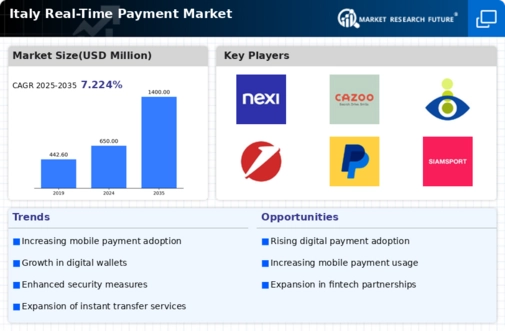Regulatory Framework Enhancements
The regulatory environment in Italy is evolving to support the growth of the real time-payment market. Recent initiatives by the government aim to promote digital payments and enhance financial inclusion. The introduction of regulations that facilitate faster payment processing and reduce transaction costs is likely to encourage more businesses to adopt real time payment solutions. Additionally, compliance with these regulations can enhance consumer trust in digital payment systems. As the regulatory framework becomes more favorable, it is expected that the real time-payment market will witness increased participation from both consumers and businesses. This supportive environment may lead to a more competitive landscape, driving innovation and improving service offerings within the industry.
E-commerce Growth and Digitalization
The ongoing growth of e-commerce in Italy is a substantial driver for the real time-payment market. With online shopping becoming increasingly popular, the need for efficient and secure payment methods is paramount. In 2025, e-commerce sales in Italy are projected to reach €50 billion, highlighting the importance of integrating real time payment solutions into online platforms. This trend is further fueled by the digitalization of businesses, which are adopting advanced payment technologies to enhance customer experiences. As more consumers turn to online shopping, the demand for real time payment options is likely to increase, prompting retailers to invest in these systems. Consequently, the real time-payment market is poised for expansion, as it aligns with the evolving landscape of digital commerce.
Increased Focus on Financial Inclusion
Financial inclusion remains a critical focus in Italy, driving the real time-payment market forward. Efforts to provide access to financial services for underserved populations are gaining momentum. The introduction of real time payment solutions can bridge the gap for individuals who lack traditional banking services, enabling them to participate in the digital economy. In 2025, it is estimated that around 20% of the Italian population will benefit from enhanced access to financial services through real time payment systems. This shift not only empowers consumers but also stimulates economic growth by fostering entrepreneurship and facilitating transactions. As initiatives aimed at promoting financial inclusion continue, the real time-payment market is likely to expand, creating opportunities for innovation and development in the industry.
Consumer Demand for Instant Transactions
Consumer behavior in Italy is increasingly favoring instant transactions, which is a key driver for the real time-payment market. As individuals seek immediate access to funds and seamless payment experiences, the demand for real time payment solutions is on the rise. Recent surveys indicate that approximately 75% of Italian consumers prefer payment methods that offer instant processing. This shift is influencing businesses to adopt real time payment systems to meet customer expectations. The convenience of instant payments not only enhances customer satisfaction but also encourages higher spending, thereby benefiting merchants. As this trend continues, the real time-payment market is expected to grow significantly, with projections suggesting a compound annual growth rate (CAGR) of around 15% over the next five years.
Technological Advancements in Payment Systems
The real time-payment market in Italy is experiencing a surge due to rapid technological advancements in payment systems. Innovations such as contactless payments, mobile wallets, and blockchain technology are reshaping the landscape. In 2025, it is estimated that over 60% of transactions in Italy will be conducted through digital platforms, reflecting a shift towards more efficient payment methods. This transformation is driven by consumer demand for speed and convenience, as well as the need for businesses to streamline operations. As technology continues to evolve, the real time-payment market is likely to expand, offering new solutions that cater to both consumers and merchants. The integration of artificial intelligence and machine learning into payment systems may further enhance transaction security and efficiency, making it a pivotal driver in the industry.





















Leave a Comment